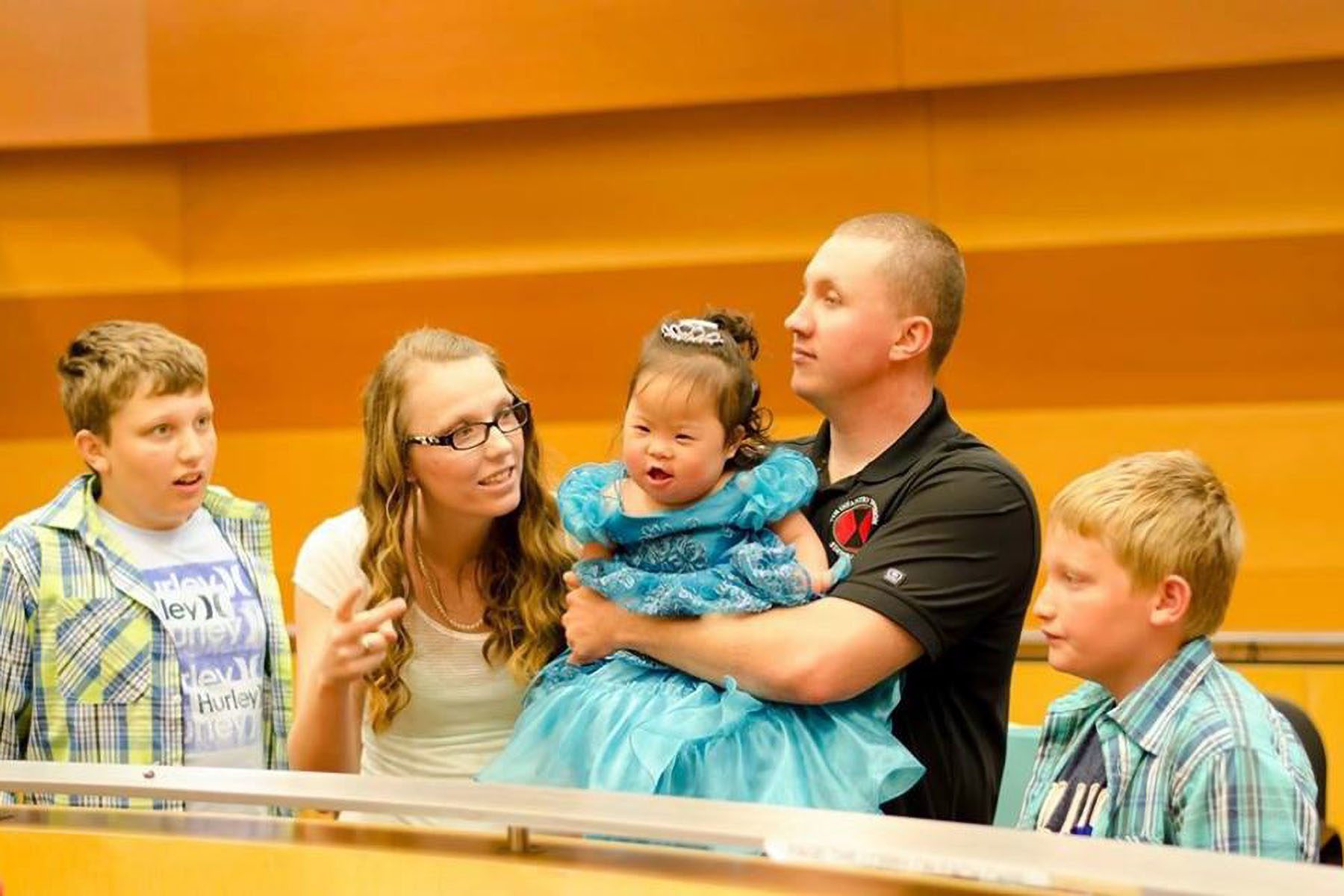Military Families Push the Army to ‘Normalize Parenthood’
A new directive addresses fertility treatment, pregnancy and postpartum recovery – issues that have long affected soldiers’ careers, marriages and home life.
Austin Carrigg wanted more children, but it wasn’t easy to grow her family, especially since her husband was an active-duty soldier in the Army. The family frequently moved from one base to another, and access to health care was in constant flux.
Carigg and her husband wanted to avoid passing on a life-threatening genetic condition that their second son was born with, so they paid for intrauterine insemination procedures — which is not covered by TRICARE, the Defense Department’s health care system — and used a sperm donor. The attempts didn’t work, and the couple couldn’t afford in vitro fertilization procedures.
Carrigg noted that there are some Army and Navy programs that offer infertility care — but those are accessible to only those fortunate enough to be assigned to certain bases.
“I’m not saying to give us unlimited tries in infertility treatments,” Carrigg told The 19th. “But especially with service members who have devoted their lives to you and now because maybe they waited too long to have a child because of their service to the military — you’re not going to cover their infertility treatment? They gave you the best of themselves. Why can’t we help them have their dream?”
Carrigg’s family ultimately adopted a child – a process that took years and cost them an amount equal to a year of her husband’s salary. Their struggle to manage their adopted daughter’s health challenges, and to even have her join their TRICARE coverage in time for surgery, eventually led Carrigg to become an advocate for military families with special needs.
Carrigg’s story, while complex, illustrates many of the challenges members of the military face in trying to grow their families. There are over 400,000 parents within the Army alone. The National Opinion Research Center at the University of Chicago estimated that more than 2 million service members and their spouses could benefit from more comprehensive infertility coverage. Thousands of parents across the force started a grassroots effort to kickstart change, which ultimately led to a new U.S. Army parenthood, pregnancy and postpartum directive announced April 21.
TRICARE, which covers people across all the military services, already offered some infertility care treatments, but only those considered “medically necessary and combined with natural conception.” The limited available options include treating physical injuries to the reproductive system and diagnostic services, such as semen analysis and hormone evaluation. TRICARE does not cover artificial insemination, any costs related to donors or semen banks or “non-coital reproductive procedures” unless the service member is married and sustained an injury while on active duty that resulted in the loss of “natural reproductive ability.” Many of these treatments are also not typically covered by private insurance or Medicaid.
The Army’s new directive doesn’t change what’s covered, but it does increase soldiers’ postpartum leave and excuse pregnant soldiers from certain physical tests and requirements. The directive contains a dozen policy changes related to fertility treatment, pregnancy loss and family care plans — half of which are new and the other half are consolidated components that had been scattered across various regulations. According to the directive, soldiers undergoing fertility treatment will be excused from deployment and field training for up to one year and given a 90-day exemption from the program that dictates height and weight standards. Families undergoing fertility treatment will be protected for a year from a move or deployment. And soldiers who receive a referral to a fertility specialist may be eligible to be transferred to another installation where treatment is available.
“We recruit soldiers, but we retain families,” Gen. James McConville, chief of staff of the Army, said in a statement announcing the new directive. “Winning the war for talent means making sure our best and brightest people don’t have to choose between service and family.”
More than 10 percent of active-duty respondents said family-building challenges are a main reason why they’d leave the military, according to an annual military family lifestyle survey conducted by Blue Star Families, a nonprofit founded in 2009 by military spouses. The Army’s new directive builds on congressional requirements and is designed to increase retention and “normalize parenthood,” according to the military branch.

Staff Sgt. Nicole Pierce is one of authors of the directive, a single mother of two daughters and the founder and administrator of several Facebook groups for mothers in the military — including “The Army Mom Life,” which has more than 8,500 members and provided feedback to the military branch. Army dads are not included in the private group due to the intimate details shared between members. Pierce, who has been in the service for nearly a decade, said these new policies would have greatly impacted her career. She had previously been told that she couldn’t get more than two days to process, mourn and recover from a medical procedure following a miscarriage. When becoming pregnant, she had repeatedly lost her slot in the professional training, development and schooling, which delayed her promotion by years.
The new policy “is a huge thing to improve quality of life,” Pierce said at an April 21 news conference announcing the directive. “In the Facebook group, we get posts every day — I would say 50 to 75 posts from Army moms. They constantly are sharing with us how the [policies] as they are right now are impacting their career, being held back from promotion or having difficulties being a breastfeeding or lactating mom.”
Weeks prior, the Blue Star Families survey, the largest and most comprehensive of its kind, found that more than two-thirds of the military community report challenges to building a family with more than 10 percent of respondents paying more than $35,000 out-of-pocket. Then in April, the American Society for Reproductive Medicine and the Military Family Building Coalition (MFBC) developed a financial model that would improve TRICARE coverage and provide comprehensive infertility coverage to active-duty military families “for a cost far lower than had been previously understood.”
Katy Bell Hendrickson, a co-founder of MFBC, said comprehensive care and coverage when it comes to reproductive health is a “military readiness issue.”
“Omitting coverage of these core family-building health needs of our active-duty military personnel has a direct impact on retention, readiness and the financial solvency of many members,” Hendrickson said in a statement. “Our country cannot afford to lose the talent and diversity of the men and women being impacted by this gap in care.”
Though it’s too soon to understand how the Army’s new policies will impact military families, particularly those experiencing infertility challenges, some service members are hopeful.
Maj. Sam Winkler, another Army mom who helped write the directive, said it was exciting to see how a grassroots effort that began in intimate soldier-to-soldier conversations worked its way into formal policy change.
“What’s so exciting about this Army directive is that we have created a true feedback loop,” Winkler said at the April news conference. “We have voices that started at the soldier level that were heard all the way by our Army senior leaders, and they listened. And they took charge and they made changes … because we came to the table with real solutions.”
Carrigg has spent a lot of time reflecting on the military and her family. In many ways, she said families struggling with infertility or in the middle of infertility treatment should be put on the Exception Family Member Program (EFMP) — an enrollment program to help soldiers with family members with physical, emotional, developmental or intellectual disabilities requiring specialized services — or a similar designation. The goal is to support these families at every stage of life instead of excluding them from service.
“I see families who are moved in the middle of treatments or adoptions, and they have to choose whether to split their family up so they can adopt or put that child back into foster care,” Carrigg said. “There should be a mechanism in place for them to stay.”
Her family also experienced some of these challenges first hand when they chose to adopt.
Over five years and three moves, she and her husband waited for birth parents to choose them. But eventually, Carrigg said, the waiting and constant disappointment became too hard. Just a few months before their registration with the adoption agency would end, Carrigg got a call: There was a newborn girl with Down syndrome who needed a home. Within days, Carrigg was on a flight by herself to pick up her daughter in Hawaii.
TRICARE does not cover any adoption expenses, but the military offers a $2,000 expense reimbursement per adopted child. In total, Carrigg said the adoption cost about $45,000 out of pocket. They were able to pay attorneys and the adoption agency in multiple payments, but she said they still dug into their life savings, sold personal belongings and even held a pancake fundraiser to manage the quick adoption turnaround.
When they arrived back home in Boston, it became immediately clear that something was very wrong. A pediatrician sent the infant to a cardiologist who said that she needed immediate open-heart surgery. The hospital asked for a $100,000 deposit, but Carrigg said they were still fighting to get her daughter put on her husband’s TRICARE plan.
“[The Defense Department] told us it’s going to be six to eight weeks, and I was like, ‘She doesn’t have six to eight weeks to live,’ and there was no process to expedite it,” Carrigg said. “There was this feeling of: I’ve waited five years for this child, and I’m going to lose her because I can’t figure out how to get her on to TRICARE?”
By an unexpected stroke of luck, Carrigg said her daughter qualified for Medicaid because the adoption papers had not yet been processed, and that agency paid for the surgery.
A few days after her 8-week-old daughter’s heart surgery, which was not covered by TRICARE, Carrigg said her baby stopped breathing and was put on a ventilator. It was during this hospital stay that Carrigg’s husband — who had recently requested not to be transferred to a base across the country because of his daughter’s medical situation — got a call from the Army. On speakerphone, according to Carrigg, with a roomful of doctors listening, a service member tasked with overseeing the family’s move suggested Carrigg and her husband “give that one back,” referring to their newly adopted daughter, and “get a new one” after the transfer. The room went silent and Carrigg’s husband quickly ended the call.
As challenge after challenge arose, Carrigg said she would never forget how she felt in those moments, when it seemed the military and its health care system might not come through for her daughter: “I took her from her birth parents, and maybe they would have been able to or maybe another adoptive family would have been able to sort this out.”
Originally published by The 19th




